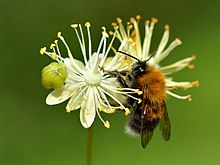Bee forage plant


A bee forage plant or bee pasture is the name given to plants that bees prefer to produce honey. They are particularly rich in nectar and pollen and are therefore often approached by honeybees .
description
Bee costume plants have for the beekeeping is very important. Many beekeepers use such plants in migratory beekeeping by deliberately setting up their colonies in the areas in which beehives are currently in bloom.
Occasionally, beekeepers plant beehive plants in order to be able to offer their bee colonies sufficient foraging. This is problematic, however, when non- local origins are specifically brought out in the wild. This so-called anointing is forbidden according to Section 40 of the Federal Nature Conservation Act - from March 2020, only local trees and seeds may be planted in the wild (i.e. outside of populated areas and outside of agricultural and forestry areas) . The case study of the giant hogweed shows that this is the case with good reason: This plant was recommended as a forage plant to beekeepers, especially in the second half of the 20th century. The spreading giant hogweed is classified as a problematic neophyte because of the health risks it poses and is targeted in many places. As individual studies have shown, giant hogweed populations often go back to such anointing by beekeepers.
Examples of beehive plants are:
- Rapeseed
- Phacelia
- Buckwheat
- Streaky Silphie
- Common robinia , which provides the "acacia honey"
- Linden tree , which supplies the linden honey , which is particularly beneficial for healing
- Crab apple as well as pome and stone fruit trees from the rose family in general
- Tansy phacelia
- Ruthenian ball thistle
- Real thyme
- Real lavender
- Real sage
- Yellow sweet clover
- Borage
- hyssop
- Seed Esparsette
- Willow trees and hazelnut bushes are early sources of pollen , ivy a late source
In many of these species, visiting bees is essential for the fruit yield, especially in fruit trees .
The increasing use of garden and balcony plants with double flowers is problematic , as these usually do not offer any nectar or pollen for bees due to the back-grown stamens.
See also
literature
- Bodo Schick, Armin Spürgin: The bee pasture . 4th edition. Ulmer , Stuttgart (Hohenheim) 1997, ISBN 3-8001-7418-9 .
- Bruno P. Kremer: My garden - a bee paradise. The 200 best bee plants. Haupt , Bern 2014, ISBN 978-3-258-07844-1
- Günter Pritsch: Bees pasture. Recognize and evaluate 200 forage plants . Kosmos , Stuttgart 2007, ISBN 978-3-440-10481-1
- Anna Maurizio , Friedgard Schaper: Das Trachtpflanzebuch. Nectar and pollen - the honeybees' main food sources . 4th edition. Ehrenwirth, Munich 1994, ISBN 3-431-03207-9
Web links
- App for bee friends with further information from the Federal Ministry of Food, Agriculture and Consumer Protection
- Bee pasture plant catalog of the state of Baden-Württemberg
- Costume for bees in the village and hall , publication by the Bavarian State Agency for Agriculture with a calendar of traditional plants (PDF; 0.9 MB)
- rundumdiebiene.de Homepage about bee pasture plants
- Die Honigmacher - Projekt Bienenweide - Online flowering calendar and traditional plants as profiles
- Beehive plants
- Bee pastures in the green encyclopedia Hortipendium
- [1] Use of the cup plant as a bee pasture
Individual evidence
- ↑ Bees-Flowers ( Memento from March 4, 2016 in the Internet Archive ) - A broadcast by Bayerischer Rundfunk on April 7, 2014
- ↑ Recommendations of the BUND on bee-friendly plants ( Memento from November 9, 2017 in the Internet Archive )

